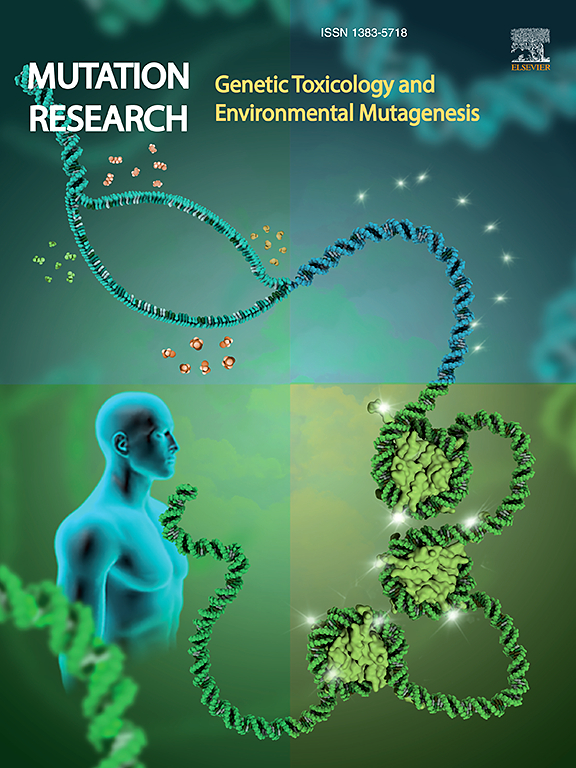细胞摄取,诱导活性氧,不同大小的钴氧化物纳米颗粒在体外人外周血单核细胞的遗传毒性
IF 2.5
4区 医学
Q3 BIOTECHNOLOGY & APPLIED MICROBIOLOGY
Mutation research. Genetic toxicology and environmental mutagenesis
Pub Date : 2025-09-10
DOI:10.1016/j.mrgentox.2025.503888
引用次数: 0
摘要
钴(II, III)氧化物纳米颗粒(Co3O4-NPs)在不同的技术和医疗领域具有潜在的应用,包括药物输送和新型抗癌治疗。然而,广泛应用可能导致高水平的人类直接暴露,引起人们对其遗传毒性潜在的担忧。本研究旨在评价Co3O4-NPs对人外周血单核细胞(PBMCs)的细胞毒性和遗传毒性。测试了两种尺寸的Co3O4-NPs(10-30 nm和<; 50 nm),以了解遗传毒性的任何尺寸依赖性差异。该研究测量了NP摄取、活性氧(ROS)产生、细胞活力、DNA链断裂、微核形成和姐妹染色单体交换,以评估Co3O4-NPs的细胞遗传毒性潜力。流式细胞分析显示,初始尺寸为<; 50 nm的Co3O4-NPs比10-30 nm的颗粒更有效地被人pbmc内化,并诱导更高的ROS水平。在非细胞毒性浓度下,这两种纳米颗粒的大小通常以剂量依赖的方式诱导了显著的原发性DNA损伤。细胞遗传学分析表明,Co3O4-NPs具有遗传毒性作用,<; 50 nm NPs比更小的纳米颗粒诱导更明显的DNA损伤和细胞活力降低。此外,还观察了暴露于Co3O4-NPs的个体间差异。研究结果表明,Co3O4-NPs在体外对人pbmc具有遗传毒性,引起了对其使用安全性的担忧。这突出了对不同细胞类型的Co3O4-NPs进行综合遗传毒性评估的必要性。本文章由计算机程序翻译,如有差异,请以英文原文为准。
Cellular uptake, induction of reactive oxygen species, and genotoxicity of differently sized cobalt oxide nanoparticles in human peripheral blood mononuclear cells in vitro
Cobalt (II, III) oxide nanoparticles (Co3O4-NPs) have potential applications in different technological and medical fields, including drug delivery and as novel anticancer treatments. However, widespread application could lead to a high-level direct human exposure, raising concerns about their genotoxic potential. This study aimed to evaluate the cytotoxicity and genotoxicity of Co3O4-NPs in human peripheral blood mononuclear cells (PBMCs) in vitro. Two sizes of Co3O4-NPs (10–30 nm and < 50 nm) were tested to understand any size-dependent differences in genotoxicity. The study measured NP uptake, reactive oxygen species (ROS) generation, cell viability, DNA strand breaks, micronuclei formation, and sister chromatid exchange to assess the cyto-genotoxic potential of Co3O4-NPs. Flow cytometric analysis revealed that Co3O4-NPs with a primary size of < 50 nm were more efficiently internalized by human PBMCs and induced higher ROS levels than 10–30 nm particles. Both nanoparticles’ sizes induced significant primary DNA damage at non-cytotoxic concentrations, often in a dose-dependent manner. Cytogenetic analysis demonstrated that Co3O4-NPs exert genotoxic effects, with < 50 nm NPs inducing more significant DNA damage and reduced cell viability than smaller nanoparticles. Additionally, interindividual differences in response to exposure to Co3O4–NPs were observed. The study findings suggest that Co3O4-NPs possess genotoxic potential in human PBMCs in vitro, raising safety concerns about their use. This highlights the need for comprehensive genotoxicity assessments of Co3O4-NPs in different cell types.
求助全文
通过发布文献求助,成功后即可免费获取论文全文。
去求助
来源期刊
CiteScore
3.80
自引率
5.30%
发文量
84
审稿时长
105 days
期刊介绍:
Mutation Research - Genetic Toxicology and Environmental Mutagenesis (MRGTEM) publishes papers advancing knowledge in the field of genetic toxicology. Papers are welcomed in the following areas:
New developments in genotoxicity testing of chemical agents (e.g. improvements in methodology of assay systems and interpretation of results).
Alternatives to and refinement of the use of animals in genotoxicity testing.
Nano-genotoxicology, the study of genotoxicity hazards and risks related to novel man-made nanomaterials.
Studies of epigenetic changes in relation to genotoxic effects.
The use of structure-activity relationships in predicting genotoxic effects.
The isolation and chemical characterization of novel environmental mutagens.
The measurement of genotoxic effects in human populations, when accompanied by quantitative measurements of environmental or occupational exposures.
The application of novel technologies for assessing the hazard and risks associated with genotoxic substances (e.g. OMICS or other high-throughput approaches to genotoxicity testing).
MRGTEM is now accepting submissions for a new section of the journal: Current Topics in Genotoxicity Testing, that will be dedicated to the discussion of current issues relating to design, interpretation and strategic use of genotoxicity tests. This section is envisaged to include discussions relating to the development of new international testing guidelines, but also to wider topics in the field. The evaluation of contrasting or opposing viewpoints is welcomed as long as the presentation is in accordance with the journal''s aims, scope, and policies.

 求助内容:
求助内容: 应助结果提醒方式:
应助结果提醒方式:


